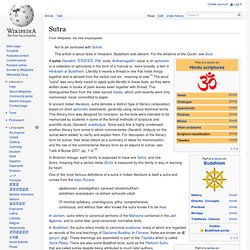

Sūtra. A sutra (Sanskrit: सूत्र, Pāli: sutta, Ardhamagadhi: sūya) is an aphorism or a collection of aphorisms in the form of a manual or, more broadly, a text in Hinduism or Buddhism.

Literally it means a thread or line that holds things together and is derived from the verbal root siv-, meaning to sew.[1] The word "sutra" was very likely meant to apply quite literally to these texts, as they were written down in books of palm leaves sewn together with thread. This distinguishes them from the older sacred Vedas, which until recently were only memorised, never committed to paper. In ancient Indian literature, sutra denotes a distinct type of literary composition, based on short aphoristic statements, generally using various technical terms. This literary form was designed for concision, as the texts were intended to be memorized by students in some of the formal methods of scriptural and scientific study (Sanskrit: svādhyāya).
Sutras primarily associated with Hinduism[edit] Vedanga[edit] Yoga Sutras of Patanjali. The Yoga Sūtras of Patañjali are 196 Indian sūtras (aphorisms) that constitute the foundational text of Ashtanga Yoga, also called Raja Yoga.

In medieval times, Ashtanga Yoga was cast as one of the six orthodox āstika schools of Hindu philosophy. The Yoga Sutras were compiled around 400 CE by Patañjali, taking materials about yoga from older traditions. Together with his commentary they form the Pātañjalayogaśāstra. Author and dating[edit] Author[edit] The Indian tradition attributes the work to Patañjali. Dating[edit] The most recent assessment of Patañjali's date, developed in the context of the first critical edition ever made of the Yoga Sūtras and bhāṣya based on a study of the surviving original Sanskrit manuscripts of the work, is that of Philipp A. Compilation[edit] The Yoga Sutras are a composite of various texts. Contents[edit] Structure of the text[edit] The eight limbs of Yoga[edit] Yama refers to the five abstentions: how we relate to the external world. Sakya Pandita. Sa'gya Paṇḍita Qoijê Sa'gya Paṇḍita Günga Gyaicain (Tibetan: ཆོས་རྗེ་ས་སྐྱ་པཎྜི་ཏ་ཀུན་དགའ་རྒྱལ་མཚན།, Wylie: chos-rje sa-skya paN+Di-ta kun-dga’ rgyal-mtshan/ (EWTS), ZYPY: Qöjê Sa'gya “Bantida” Günga Gyäcän; alt.

Choeje Sakya Pandita Kunga Gyeltse, {mo|Сажа Бандид Гунгаажалцан}), also known as Günga Gyaimcain Bai Sangbo (Tibetan: ཀུན་དགའ་རྒྱལ་མཚན་དཔལ་བཟང་པོ།[citation needed], Wylie: kun-dga’ rgyal-mtshan dpal bzang-po/, ZYPY: Günga Gyämcän Bä Sangbo; alt. Kunga Gyaltshan Pal Zangpo; 1182–1251) was a Tibetan spiritual leader and Buddhist scholar and the fourth of the Five Venerable Supreme Sakya Masters of Tibet.[1] Günga Gyaicain is generally known simply as Sa'gya Paṇḍita, a title given to him in recognition of his scholarly achievements and knowledge of Sanskrit. He is held in the tradition to have been an emanation of the Bodhisattva Manjushri, the embodiment of the wisdom of all the Buddhas.[2] After the death of Genghis Khan in 1227, the Tibetans stopped sending tribute. Works[edit]